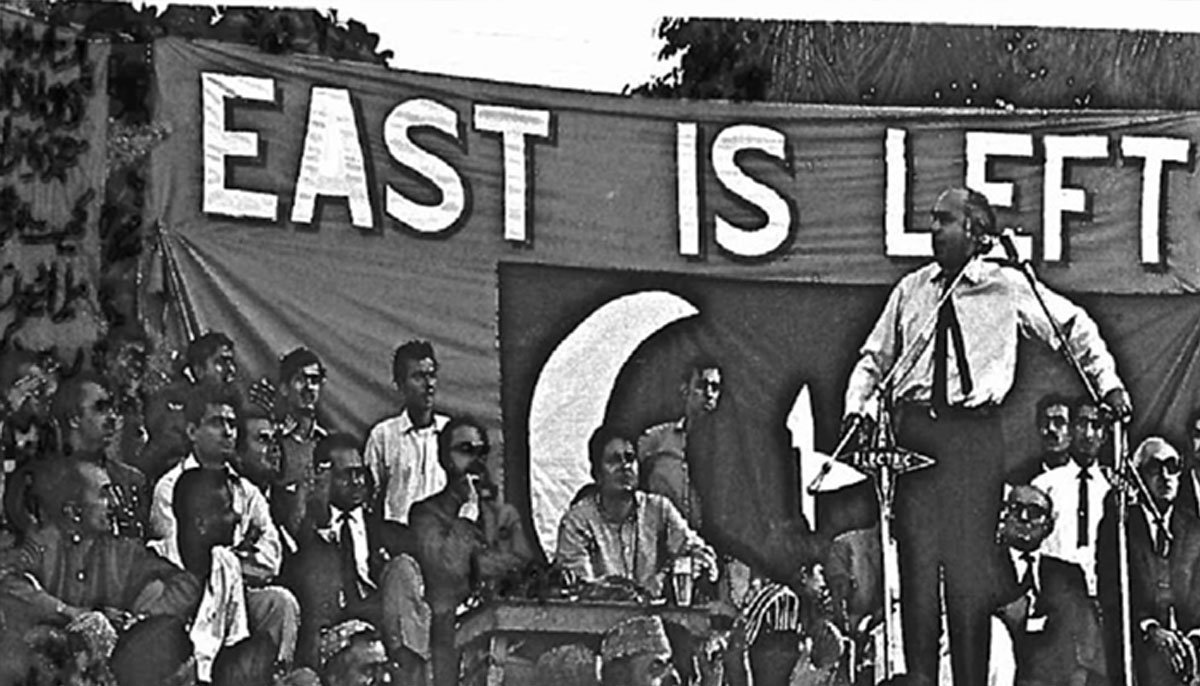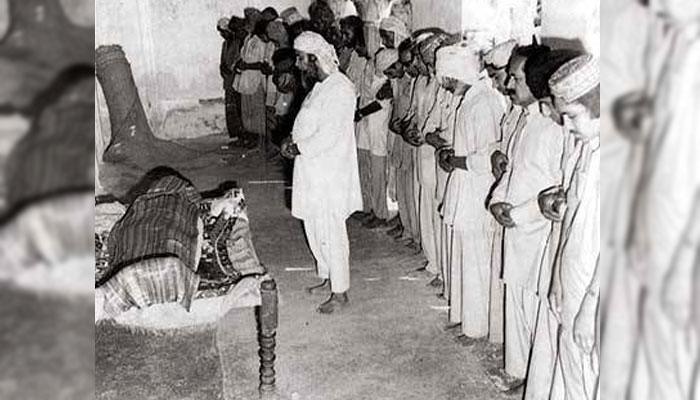Perhaps it is fitting that the Pakistan People’s Party’s (PPP) supporters are called ‘jiyalas’. Seen as a ‘party of martyrs’, the PPP has traditionally stood as the political line of defence against an interventionist state apparatus that has used democratic parties as pawns in an undemocratic game of power. But, while the revolutionary tag may still be applied to the party by its stauncher supporters, the PPP has come a long way from its inception.
The PPP was founded in 1967 by the charismatic Zulfikar Ali Bhutto, arguably Pakistan’s first populist leader who used a moment in history to fashion his politics in the idiom of other populist leaders of the time and captured the imagination of a country that was attracted by the heady mix of socialism and Islamism he offered. This ‘Islamic socialism’ by Bhutto would cease to be with Bhutto’s death but Bhuttoism survived in the jiyala, in the party, and in the Bhutto dynasty that continues to this day.
Despite Bhutto’s use of religion in politics, the PPP has continued to sell itself as a left-of-centre party, offering a ‘socialist-democratic’ revolution in 1967 after the ouster of Ayub Khan’s regime. Launched in Lahore, Bhutto’s PPP immediately attracted a mix of students, young left-wing leaders, progressives, and unionists of all colours.
In the 1970s elections, the slogan ‘Roti, Kapra aur Makaan’ laid the basis for what the party said it stood for — providing the people with the essentials of a dignified existence. The elections in 1970 saw the then East Pakistan going to Sheikh Mujibur Rehman’s Awami League (AL). The PPP swept the elections in West Pakistan. Discriminatory policies and a disaffected populace led to East Pakistan separating and becoming Bangladesh in 1971. The Pakistan of today thus came to be ruled by Bhutto’s PPP.

Under Bhutto, the PPP introduced a series of economic and social reforms after 1971. From the nationalisation of major industries to land reforms to giving Pakistan its first real constitution — which has survived to date — Bhutto’s ‘Islamic socialism’ is a contentious subject to this day. Party jiyalas still adhere to what they say was Bhutto’s pro-poor policies.
But critics say Bhutto had by 1973 started moving away from his reformist agenda. His government cracked down on unions, dismissed the NAP government in Balochistan and then succumbed to the more conservative elements within by passing the Second Amendment.

Matters came to a head in 1977 when the PPP won 155 of the 200 seats in the National Assembly with 58% of the total votes cast. The Pakistan National Alliance (PNA), a coalition of nine parties opposing the PPP, won only thirty-six seats.
The PNA alleged electoral fraud. The ensuing chaos paved the way for martial law imposed by Gen Ziaul Haq, who would go on to stay in power for more than a decade and is still remembered as having headed Pakistan’s most brutal dictatorial regime.
In what is now called a ‘judicial murder’, Zia had Bhutto executed in 1979 in a trumped-up murder trial. Bhutto’s widow, Nusrat Bhutto, was left with a party whose leaders were either incarcerated or on the run.

The PPP would be rescued by Benazir Bhutto, the young daughter of Zulfiqar Ali Bhutto, who helped form the Movement for the Restoration of Democracy (MRD). With the death of Gen Zia in an air crash, Benazir’s PPP contested the 1988 elections and won, Benazir becoming the first woman leader of a Muslim nation in modern history.
Benazir first cleaned house and then shifted the party’s ideology from her father’s mix of socialism and Islamism to a more left-liberal tangent. Meanwhile, Pakistan’s politics continued its game of musical chairs between Benazir’s PPP and Nawaz Sharif’s IJI and then the Pakistan Muslim League-Nawaz (PML-N).

The PPP also continued to bear the brunt of a less-than-savoury relationship with the country’s military leadership. In August 1990 then-president Ghulam Ishaq Khan dismissed the Benazir government on charges of corruption. In the election held in October of that year, the PPP lost to the IJI.
The 1990s and after saw a larger push by the establishment to paint most political parties with the same tainted brush of ‘corruption’ and ‘incompetence’. Benazir and her PPP were dealt a harsher hand.

A party associated with anti-establishment policies being led by a woman – everything needed to pull it down was employed. Later on though, as many would argue, the party did itself no favours – almost internalising the graft and incompetence charges it was accused of.
Benazir Bhutto’s terms in power were not without a fair share of groundbreaking policies. Under Benazir, Pakistan saw its first women police stations and the launch of the Lady Health Workers Programme (1994).
Her work to promote Pakistan’s foreign policy initiatives may have also laid the foundations for a direction then followed by successive governments. While it was launched after her death, Benazir was part of the inception process of the Benazir Income Support Program which provides low-income families cash support through women.

But more than anything else, Benazir Bhutto came to be associated with Pakistan’s yearning for democracy.
In 1999, as Musharraf took over, Benazir went into exile in London and Dubai. She was not allowed to contest the 2002 polls due to the Musharraf regime passing a rule banning prime ministers from serving a third term. In addition, the PPP had to ‘split’ to bypass legislation in 2000 that prohibited a court-convicted individual from holding party office.

Post-1999 also saw Benazir trying to encourage ‘reconciliatory politics’ which culminated in the form of the Charter of Democracy signed between her and Nawaz Sharif. Benazir returned to Pakistan in October 2007 – a homecoming marred by a terror attack on her welcome rally. While she survived that, the PPP lost its iconic and beloved leader in a subsequent attack in December 2007 in Rawalpindi.
The PPP was once again not just without a leader but without a ‘Bhutto’ at the helm. The Asif Ali Zardari era of the PPP thus started on a sombre note.

Zardari’s challenge was to not only steer a grieving party towards elections but also keep it intact for the eventual successor – Bilawal Bhutto-Zardari – to take over. Despite the varying tags of corruption associated with Zardari, it would be a fair assessment that he managed to move the PPP towards a sense of stability post-Benazir’s assassination.
But Zardari’s PPP also marked a stronger shift to pragmatic politics. Known as Pakistan’s shrewdest political mind, Asif Ali Zardari’s ability to forge alliances with the impossible is still marvelled at even by his harshest critics.
After the PPP came to power in the 2008 elections, Zardari became president of the country, and Pakistan saw greater effort at constitutionalism. The PPP’s main claim to fame in recent history can easily be the 18th Amendment during its 2008-2013 tenure.

The PPP also worked to bring Balochistan back into the national mainstream, increasing the province’s share in the NFC Award and putting forward the Aghaz-e-Huqooq-e-Balochistan package.
Election 2013 saw the PML-N taking power in the centre, but the PPP retained its Sindh power seat. Then came the 2018 elections, marred by some of the worst controversies the country had seen since the late 90s.
During Imran Khan’s tenure, Zardari’s PPP continued to work with the PML-N to oust Imran from power using constitutional means. In its fourth iteration now, with Bilawal largely at the helm, the PPP of 2024 is once again going through a generational transition.

So, what will Bilawal’s PPP look like? For one, he is trying to appeal to the younger voters for the February 8 election. The party is also trying to reach out to PTI supporters who are now largely left without a leader and a unified party symbol.
To do that, Bilawal has been trying to shed the PDM government tag. But his detractors point out that this may not be as simple. In the PDM coalition government, Bilawal came into his own as the country’s foreign minister. Well-spoken and a throwback to his mother in many ways, Bilawal did well. However, critics say the PPP is trying to get away with trying to distance itself from the missteps and failings of a government it was an equal partner in.

For the February 8 election, the PPP is looking to also woo the PTI-affiliated independents who are now up for grabs given that the rule of party discipline and floor-crossing no longer binds them.
The party’s manifesto is certainly ambitious. Using the slogan ‘Chuno Nai Soch Ko’ (elect the new vision), in keeping with what the party is selling: ‘new’, ‘young’ ‘untried’, the PPP says it will tackle poverty, and ensure healthcare, education, food security and women’s empowerment.

The party is set to retain its Sindh power seat, and perhaps get some electable independents on its side in Balochistan, and while winning in Punjab is not on the cards, there are a few seats it looks good to grab, say analysts. In the final estimation, while the PPP may no longer be the ‘party of resistance’, it is still seen as the more progressive of the mainstream parties in the country.
Perhaps the biggest challenge the young Bilawal faces is shedding the baggage of the past while also keeping both resistance and pragmatism in equal balance.
The writer is Op-Ed Editor The News. She posts @zburki
— Header and thumbnail design by IMM Creative


